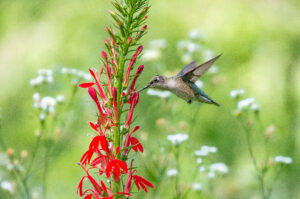
Cardinal Flower: A Vibrant Native Plant for Wet Soils
Cardinal flowers are striking plants that add a pop of vibrant red to gardens and natural areas. These tall, slender perennials bloom in late summer
Ground shipping is currently paused. Local deliveries throughout Long Island will continue as usual. Pre-orders for fall are now open. Non-local orders will begin shipping again in early September. Click here to learn more.

Pussy willows are a beloved sign of spring’s arrival. These fuzzy catkins appear on willow shrubs before their leaves emerge. Their soft, silvery buds resemble tiny cat paws, giving them their charming name.

You can grow pussy willows in your own garden with minimal effort. They thrive in moist soil and full sun to partial shade.
Pussy willows are fast-growing and can reach heights of 15-25 feet.
Many cultures have traditions involving pussy willows. In some Eastern European countries, people use them instead of palms on Palm Sunday. Pussy willows also feature in various spring crafts and floral arrangements.
Pussy willows are unique shrubs known for their soft, fuzzy catkins and ecological importance. They play a role in various cultural traditions and have distinctive botanical features.
Pussy willows belong to the Salix genus in the Salicaceae family. You’ll find several species, including Salix discolor, Salix caprea, and Salix cinerea.
These plants are dioecious, meaning male and female flowers grow on separate plants.
Pussy willows are deciduous shrubs or small trees. They grow 6-25 feet tall, depending on the species.
Their branches are thin and flexible. The leaves are oval or lance-shaped with smooth or slightly toothed edges.
The most famous feature is the catkin, or flower cluster. Male catkins are silver and fuzzy, giving them a “pussy cat” look. Female catkins are greenish and less showy.
Catkins appear in late winter or early spring before the leaves.
Pussy willows hold special meaning in many cultures. You’ll often see them used in Easter and spring decorations in Western countries. Their appearance marks the end of winter and start of spring.
In Eastern Europe, pussy willow branches replace palm fronds on Palm Sunday. People believe they bring good luck and ward off evil spirits.
In China and other Asian countries, pussy willows are important for Lunar New Year celebrations. They symbolize growth and prosperity for the coming year.
Some Native American tribes used pussy willows for medicinal purposes. The bark contains salicin, similar to aspirin. People made tea from the bark to treat fevers and pain.

Pussy willows thrive in specific conditions. You’ll need to consider soil, light, and moisture to help them flourish.
Pussy willows like moist, well-draining soil. Loamy soil works best.
You can improve heavy clay soil by adding organic matter. This helps with drainage.
Sandy soil needs extra organic matter too. It helps hold moisture.
Test your soil pH. Pussy willows prefer slightly acidic to neutral soil. The ideal pH range is 6.0 to 7.0.
You can adjust pH with lime or sulfur if needed.
In wetlands, pussy willows grow naturally in saturated soil. But in your garden, make sure the soil doesn’t stay waterlogged. This can lead to root rot.
Pussy willows do best in full sun to partial shade. They need at least 6 hours of direct sunlight daily.
In hot climates, some afternoon shade can be helpful.
These plants are hardy in zones 4-8 in North America. They can handle cold winters and hot summers.
In zone 4, protect young plants from harsh winds.
Spring and fall are ideal for planting. This gives roots time to establish before extreme temperatures hit.
Pussy willows love moisture. They grow well near ponds or streams.
In your garden, keep the soil consistently moist. Water deeply once or twice a week.
Young plants need more frequent watering. Once established, pussy willows are drought-tolerant. But they’ll look their best with regular water.
In dry spells, water more often. A layer of mulch helps retain soil moisture. It also keeps roots cool in summer heat.
Avoid overwatering in poorly-drained soils. This can lead to root problems. If leaves turn yellow, you might be watering too much.
Pussy willows need proper care to stay healthy and attractive. Regular maintenance keeps them thriving and looking their best.
Pussy willows don’t need much fertilizer. Use a balanced, slow-release fertilizer once a year in spring.
Sprinkle it around the base of the plant. Don’t let it touch the stems.
Add compost or well-rotted manure to the soil each year. This improves soil health and feeds the plant.
Spread a 2-inch layer around the base, keeping it away from the stems.
If your soil is very poor, you can fertilize again in early summer. Use half the amount you used in spring.
Too much fertilizer can harm pussy willows, so be careful not to overdo it.
Prune pussy willows in late winter or early spring before new growth starts. This encourages lots of new shoots with catkins.
For a bushy plant, cut all stems back to 4-6 inches above ground level. This is called coppicing. It keeps the plant compact and produces many new stems.
To shape the plant, remove old, damaged, or crossing branches. Cut these back to a main stem or to the ground. This improves air flow and the plant’s shape.
Leave some older stems if you want larger pussy willows. These will grow taller and produce catkins higher up.
Pussy willows can get aphids. These small insects cluster on new growth. Spray them off with a strong stream of water.
If that doesn’t work, try insecticidal soap.
Watch for scab, a fungal disease that causes dark spots on leaves. Remove infected leaves and dispose of them.
Improve air flow by pruning.
Canker can kill branches or whole plants. Cut out infected areas, sterilizing tools between cuts. Prune in dry weather to prevent spread.
Leaf spots and anthracnose are other fungal problems. Pick off affected leaves. Avoid overhead watering to keep foliage dry.
Pussy willows can be grown from cuttings or repotted to keep them healthy. These methods allow you to expand your collection or maintain existing plants.
To propagate pussy willows, take 6-8 inch cuttings from young branches in early spring. Remove lower leaves and place the cuttings in water or moist soil.
Keep them in a bright spot but out of direct sunlight. Roots will form in 2-3 weeks.
Once rooted, plant the cuttings in pots with well-draining soil. Water regularly and protect from strong winds.
You can also propagate pussy willows by dividing mature plants in spring or fall.
Repot pussy willows every 2-3 years or when they outgrow their current container.
Choose a pot 1-2 inches larger than the current one. Use a mix of potting soil and compost for good drainage.
Spring is the best time to repot. Gently remove the plant from its old pot. Loosen the root ball and trim any damaged roots.
Place it in the new pot and fill with soil. Water well after repotting.
For overwintering, move potted pussy willows to a sheltered spot or unheated garage. Water sparingly until spring.
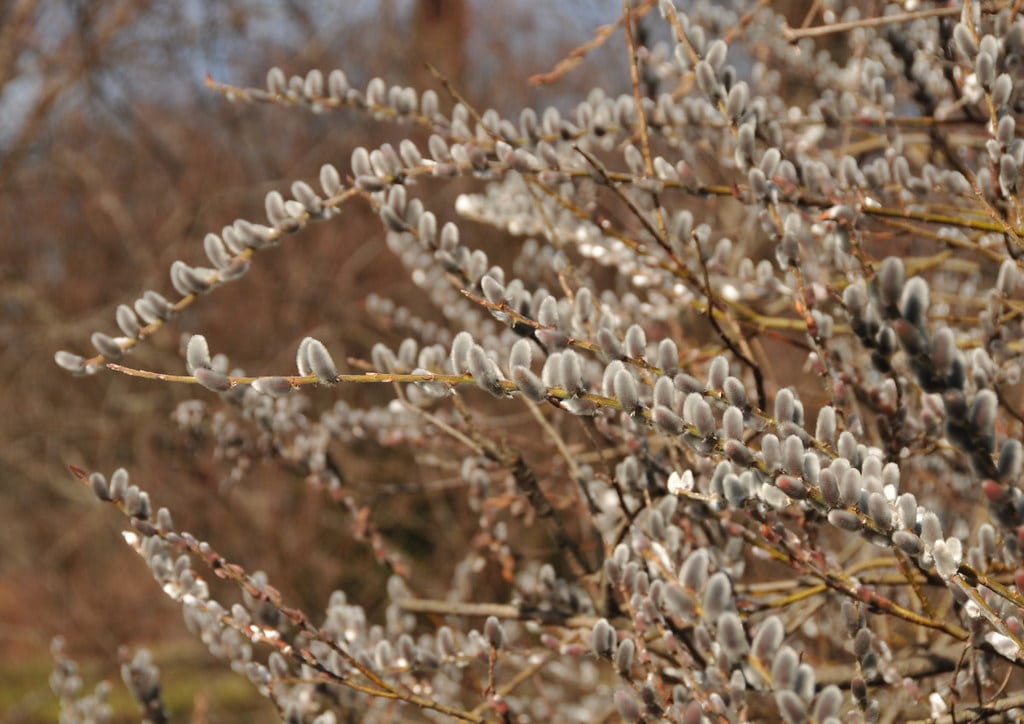
Pussy willows play a vital role in local ecosystems. They offer food and shelter to wildlife while helping to stabilize soil and prevent erosion.
Pussy willows are a boon for many creatures. In early spring, their fuzzy catkins provide pollen for bees when few other sources are available.
You’ll often see butterflies and other insects feeding on the nectar of pussy willow flowers.
Birds use pussy willows for nesting materials and shelter. The dense branches offer safe spots for building homes and hiding from predators.
Small mammals like rabbits and mice also find refuge in pussy willow thickets.
Many native species rely on pussy willows as a food source. Deer and elk browse on the tender shoots and leaves. Beavers use the branches to build their dams and lodges.
Pussy willows are champs at preventing soil erosion. Their extensive root systems help hold soil in place along streams and riverbanks.
This keeps sediment out of waterways and protects water quality.
You’ll often see pussy willows planted to stabilize slopes and prevent landslides. Their roots spread quickly, creating a living net that binds soil particles together.
As pussy willows grow and shed leaves, they add organic material to the soil. This improves soil structure and fertility over time. The enhanced soil can then support a wider range of plant and animal life.
Pussy willows add unique texture and visual interest to gardens and landscapes. Their fuzzy catkins and slender branches make them versatile for both ornamental and practical purposes.
You can use pussy willows as eye-catching focal points in your garden. Plant them near water features or in damp areas for a natural look.
The catkins make great cut branches for indoor flower arrangements. Clip stems in late winter before leaves appear for the best display. Pussy willows also work well in dried arrangements that last for months.
For seasonal decor, you can force cut branches to bloom indoors. Place stems in water in a warm spot to encourage catkins to open early. Use these as festive spring decorations around your home.
Pussy willows offer interesting structure to your landscape design. Their arching branches create graceful silhouettes, especially in winter.
You can plant them as hedges or screens for privacy. Prune yearly to control size and shape.
The weeping pussy willow variety adds drama with its cascading form. Use it as a standalone specimen tree for visual impact. Pussy willows also work well for erosion control on slopes or stream banks. Their extensive root systems help hold soil in place.
Pussy willows bring unique seasonal charm to gardens. They offer interesting varieties with different bloom times and catkin colors.
Pussy willows are early bloomers. You’ll see their fuzzy catkins appear in late winter or early spring. This happens before their leaves grow. Male and female plants have different catkins. Male catkins are often showier and more sought-after.
Some pussy willows bloom as early as February in mild climates. Others may wait until April in colder areas. The exact timing depends on your local weather. Catkins usually last for several weeks. After blooming, pussy willows grow green leaves for the rest of the growing season.
You can choose from several pussy willow varieties. Each has unique features:
Goat Willow and Grey Willow are common in Europe. They have similar fuzzy catkins. Weeping Willow is a related species with drooping branches. It’s often planted near water.
Some varieties bloom earlier or later than others. This lets you extend the pussy willow season in your garden.
Caring for pussy willow plants involves proper planting, pruning, pest control, propagation, watering, and landscaping. Here are answers to common questions about growing these popular shrubs.
Pussy willows thrive in moist, well-draining soil. They prefer full sun to partial shade. Plant them in spring or fall, spacing them 6-10 feet apart. These hardy shrubs grow best in USDA zones 4-8.
Prune pussy willows in late winter or early spring before new growth starts. Cut back about one-third of the oldest stems to ground level. Remove any dead, damaged, or crossing branches. This encourages new growth and maintains the plant’s shape.
Willow leaf beetles and gypsy moths can damage leaves. Prune affected areas and use insecticidal soap if needed. Willow scab and black canker are fungal diseases. Improve air circulation and avoid overhead watering to prevent these issues.
Pussy willows are easy to propagate from cuttings. Take 6-8 inch cuttings from young stems in spring or early summer. Remove lower leaves and place the cuttings in water or moist soil. Roots should form within 2-3 weeks.
Water pussy willows deeply once a week during their first growing season. Established plants need less frequent watering. Fertilize in early spring with a balanced, slow-release fertilizer. Avoid over-fertilizing, as this can lead to weak growth.
Pussy willows work well as hedges, screens, or focal points in gardens. They add interest to winter landscapes with their fuzzy catkins.
Use them near water features or in rain gardens. Their flexible branches are great for flower arrangements and crafts.

Cardinal flowers are striking plants that add a pop of vibrant red to gardens and natural areas. These tall, slender perennials bloom in late summer

New York native plants are essential for sustaining local ecosystems. They provide food and shelter for wildlife while helping to maintain soil health. Incorporating native

Rose milkweed is a beautiful native plant that can add color and life to your garden. This perennial flower, also known as Asclepias incarnata, grows
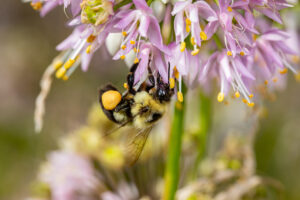
Nodding onion plant is a charming native plant found across North America. Its drooping pink or white flower clusters add a whimsical touch to gardens




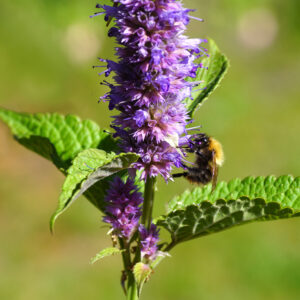
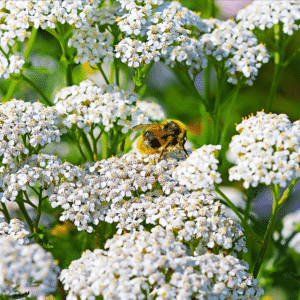
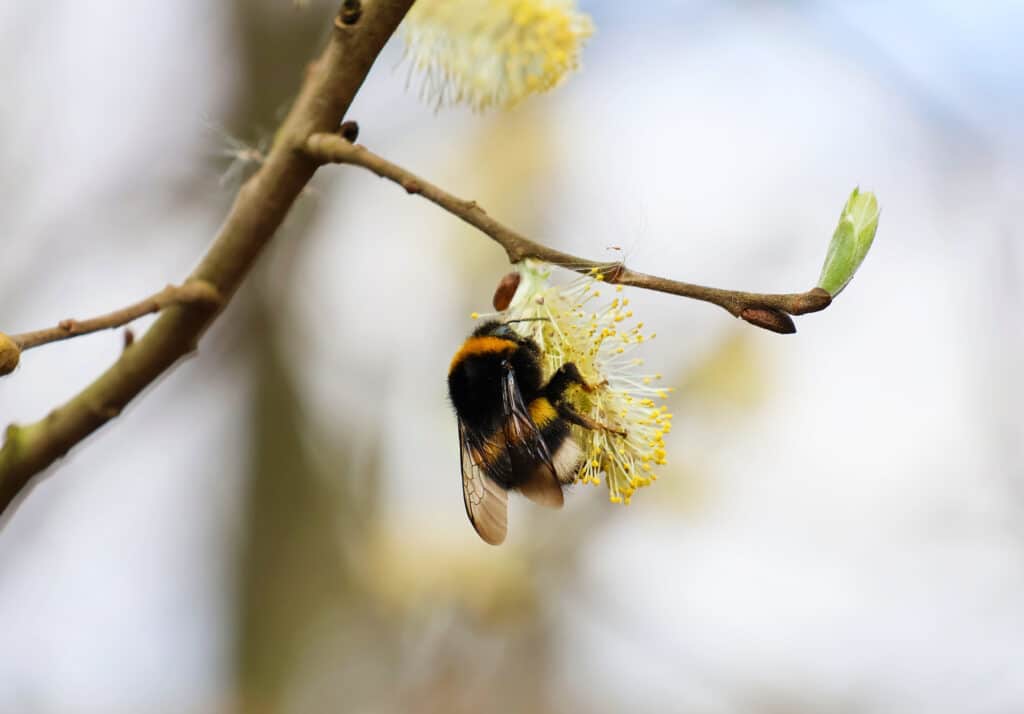
Only Local Delivery Available (Long Island & Queens)
Ground Shipping Paused
To protect our plants from extreme summer heat, we’ve paused nationwide ground shipping to avoid any damage during transit.
Local Delivery Only
We’re still delivering locally to Long Island and Queens, so nearby customers will continue to receive orders as usual.
Fall Pre-Orders Are Open Nationwide!
We will resume normal shipping for non-local orders placed during the pause in early September.
Thank you for your support and understanding—we’re looking forward to growing with you this fall!